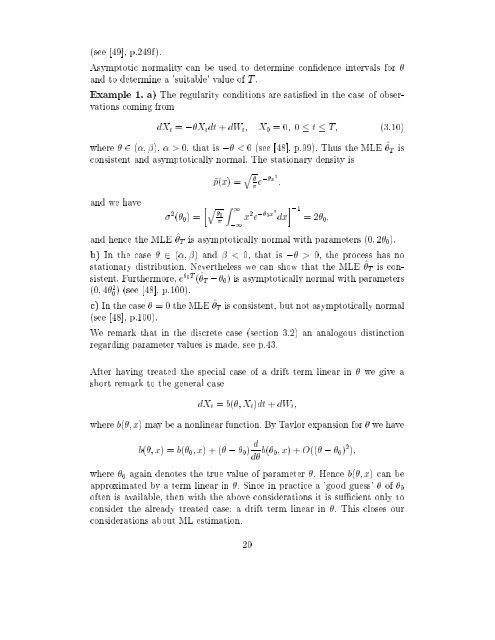Estimation in Financial Models - RiskLab
Estimation in Financial Models - RiskLab
Estimation in Financial Models - RiskLab
Create successful ePaper yourself
Turn your PDF publications into a flip-book with our unique Google optimized e-Paper software.
(see [49], p.249f).<br />
Asymptotic normality can be used to determ<strong>in</strong>e condence <strong>in</strong>tervals for <br />
and to determ<strong>in</strong>e a 'suitable' value of T .<br />
Example 1. a) The regularity conditions are satised <strong>in</strong> the case of observations<br />
com<strong>in</strong>g from<br />
dX t = ,X t dt + dW t ; X 0 =0; 0 t T; (3.10)<br />
where 2 (; ), >0, that is , 0, the process has no<br />
stationary distribution. Nevertheless we can show that the MLE ^ T is consistent.<br />
Furthermore, e 0T (^ T , 0 ) is asymptotically normal with parameters<br />
(0; 40) 2 (see [48], p.100).<br />
c) In the case = 0 the MLE ^ T is consistent, but not asymptotically normal<br />
(see [48], p.100).<br />
We remark that <strong>in</strong> the discrete case (section 3.2) an analogous dist<strong>in</strong>ction<br />
regard<strong>in</strong>g parameter values is made, see p.43.<br />
After hav<strong>in</strong>g treated the special case of a drift term l<strong>in</strong>ear <strong>in</strong> we give a<br />
short remark to the general case<br />
dX t = b(; X t )dt + dW t ;<br />
where b(; x) may be a nonl<strong>in</strong>ear function. By Taylor expansion for we have<br />
b(; x) =b( 0 ;x)+( , 0 ) d d b( 0;x)+O(( , 0 ) 2 );<br />
where 0 aga<strong>in</strong> denotes the true value of parameter . Hence b(; x) can be<br />
approximated by a term l<strong>in</strong>ear <strong>in</strong> . S<strong>in</strong>ce <strong>in</strong> practice a 'good guess' of 0<br />
often is available, then with the above considerations it is sucient only to<br />
consider the already treated case: a drift term l<strong>in</strong>ear <strong>in</strong> . This closes our<br />
considerations about ML estimation.<br />
20
















